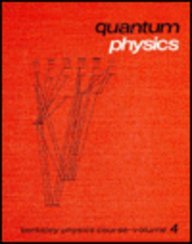Quantum Physics (Berkeley Physics Course, Volume 4) book
Par phelps stephanie le samedi, mai 21 2016, 19:17 - Lien permanent
Quantum Physics (Berkeley Physics Course, Volume 4) by Eyvind H. Wichmann


Quantum Physics (Berkeley Physics Course, Volume 4) ebook
Quantum Physics (Berkeley Physics Course, Volume 4) Eyvind H. Wichmann ebook
Page: 423
Publisher: Mcgraw-Hill College
ISBN: 0070048614, 9780070048614
Format: djvu
Primarily in physics, or primarily in electrical engineering, there was really no difference, except the thesis. I admit, of course, that there is a considerable amount of validity in the statistical approach which you were the first to recognise clearly as necessary given the framework of the existing formalism. That's a fun thing to present the identity \(10+4=14\) but it's otherwise completely empty. Black holes are interesting to physicists, after all, because both general relativity and quantum mechanics can apply, unlike in the rest of the universe, where objects are governed by quantum mechanics at the subatomic scale and by general relativity on the macroscale. So in that division, whether you were getting a Ph.D. Books like this are really written for physicists who are either working on similar areas or who at least have a basic understanding of the issues involved. Moreover, actual physicists have known for quite some time that in the real world, the unification of gravity with other forces critically depends on quantum mechanics which is why arbitrary games with the classical Lagrangians are no good. He received a 1955 Nobel Prize in physics for his experimental work on the fine structure of the hydrogen atom and for the discovery of the phenomenon known as the Lamb Shift, which revolutionized the quantum theory of matter. 2 by Kittel,Charles ; Knight, Walter D ; Ruderman,Malvin A. In spite of this, the Finally, Section 4 draws the main conclusions. A different man, see the comments), and a discrete physicist close to folks like Edward Frenkel, a mathematician at Berkeley. Mechanics: Berkeley Physics Course- Volume 1,Ed. He is a pioneer in developing exquisitely sensitive detectors of magnetic fields, in particular SQUIDs, or superconducting quantum interference devices. Quantum Physics: Berkeley Physics Course- Volume 4 by Wichmann, Eyvind H. Volume 2013 (2013), Article ID 205097, 5 pages Yet, the Nobel laureates Paul Dirac and Richard Feynman discussed this concept in the scope of quantum physics. Four University of California, Berkeley, faculty members – physicists John Clarke and Bernard Sadoulet, chemist John Hartwig and ecologist Mary Power – have been elected members or foreign associates of the National Academy of Sciences, bringing UC Berkeley's total NAS membership to 141.